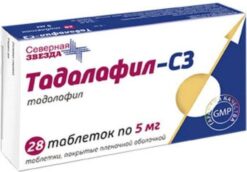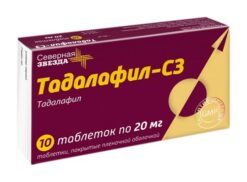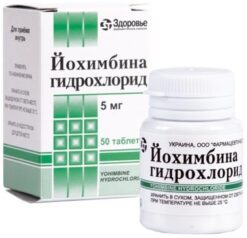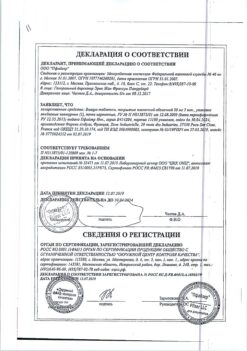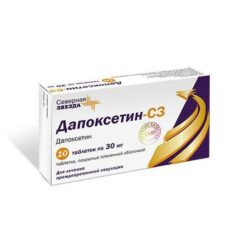No products in the cart.
Tamsulosin retard, 0.4 mg 30 pcs
€21.61 €18.01
Description
Pharmacotherapeutic group:
an alpha1-adrenoblocker.
ATX code: G04CA02.
Pharmacological properties:
Pharmacodynamics
Tamsulosin is a specific blocker of postsynaptic alpha1-adrenoreceptors located in the smooth muscle of the prostate, bladder neck and prostatic urethra.
Blockade of alpha1-adrenoreceptors by tamsulosin leads to decrease of tone of the smooth muscles of the prostate, bladder neck and prostatic part of the urethra and improves outflow of urine. Simultaneously both symptoms of emptying and symptoms of filling caused by increased tone of smooth muscles and detrusor hyperactivity in benign prostatic hyperplasia (BPH) are reduced.
The ability of tamsulosin to affect alpha1A subtype of adrenoreceptors is 20 times greater than its ability to interact with alpha1B subtype of adrenoreceptors located in vascular smooth muscle.
Owing to its high selectivity, tamsulosin does not cause clinically significant reductions in systemic arterial blood pressure (BP) in both patients with arterial hypertension and patients with normal BP.
Pharmacokinetics
Absorption
Tamsulosin is well absorbed in the intestine and has almost 100% bioavailability. Absorption of tamsulosin slows down slightly after meals. The same level of absorption can be achieved if the patient takes the drug after the usual breakfast each time. Tamsulosin is characterized by linear kinetics. After a single oral dose of 0.4 mg of the drug, its maximum plasma concentration (Cmax) is reached after 6 hours. After multiple oral doses of 0.4 mg per day, the equilibrium concentration (Csс) is reached by day 5, and its value is approximately 2/3 that of a single dose.
Distribution
The binding to plasma proteins is 99%, the volume of distribution is small (about 0.2 L/kg).
Metabolism
Tamsulosin is slowly metabolized in the liver to form less active metabolites. Most of tamsulosin is present in plasma in unchanged form.
In the experiment the ability of tamsulosin to slightly induce the activity of microsomal liver enzymes was revealed. In mild to moderate hepatic insufficiency there is no need to adjust the dosing regimen.
Tamsulosin and its metabolites are primarily excreted by the kidneys, with approximately 9% of the drug excreted unchanged.
The elimination half-life (T½) of the drug is 10 hours with a single dose of 0.4 mg after a meal, and 13 hours with multiple doses. There is no need to decrease the dose in renal failure, but in patients with severe renal insufficiency (creatinine clearance (CK) less than 10 ml/min) tamsulosin administration should be used with caution.
Indications
Indications
Treatment of dysuric disorders in benign prostatic hyperplasia.
Pharmacological effect
Pharmacological effect
Pharmacotherapeutic group:
alpha1-blocker.
ATX code: G04CA02.
Pharmacological properties:
Pharmacodynamics
Tamsulosin is a specific blocker of postsynaptic alpha1-adrenergic receptors located in the smooth muscles of the prostate gland, bladder neck and prostatic urethra.
Blockade of alpha1-adrenergic receptors by tamsulosin leads to a decrease in the tone of the smooth muscles of the prostate gland, bladder neck and prostatic urethra and improves urine outflow. At the same time, both emptying and filling symptoms are reduced, due to increased smooth muscle tone and detrusor overactivity in benign prostatic hyperplasia (BPH).
Tamsulosin’s ability to act on the alpha1A subtype of adrenergic receptors is 20 times greater than its ability to interact with the alpha1B subtype of adrenergic receptors, which are located in vascular smooth muscle.
Due to its high selectivity, tamsulosin does not cause a clinically significant decrease in systemic blood pressure (BP) both in patients with arterial hypertension and in patients with normal blood pressure.
Pharmacokinetics
Suction
Tamsulosin is well absorbed from the intestine and has almost 100% bioavailability. The absorption of tamsulosin slows down somewhat after eating. The same level of absorption can be achieved if the patient takes the drug after a normal breakfast each time. Tamsulosin is characterized by linear kinetics. After a single oral dose of 0.4 mg of the drug, its maximum concentration in the blood plasma (Cmax) is achieved after 6 hours. After repeated oral administration of 0.4 mg per day, the equilibrium concentration (Css) is reached by the 5th day, while its value is approximately 2/3 higher than the value of this parameter after taking a single dose.
Distribution
Plasma protein binding is 99%, the volume of distribution is small (about 0.2 l/kg).
Metabolism
Tamsulosin is slowly metabolized in the liver to form less active metabolites. Most of tamsulosin is present in the blood plasma in unchanged form.
The experiment revealed the ability of tamsulosin to slightly induce the activity of microsomal liver enzymes. With minor and moderate degrees of liver failure, no adjustment of the dosage regimen is required.
Removal
Tamsulosin and its metabolites are primarily excreted by the kidneys, with approximately 9% of the drug excreted unchanged.
The half-life of the drug (T½) with a single dose of 0.4 mg after meals is 10 hours, with multiple doses – 13 hours. In case of renal failure, no dose reduction is required; if the patient has severe renal failure (creatinine clearance (CC) less than 10 ml/min), tamsulosin should be prescribed with caution.
Special instructions
Special instructions
As with the use of other alpha1-blockers, when treated with Tamsulosin retard, in some cases a decrease in blood pressure may be observed, which can sometimes lead to fainting. At the first signs of orthostatic hypotension (dizziness, weakness), the patient should sit or lie down and remain in this position until the signs disappear.
During surgical interventions for cataracts while taking the drug, the development of intraoperative instability syndrome of the iris (narrow pupil syndrome) is possible, which must be taken into account by the surgeon for preoperative preparation of the patient and during the operation. The advisability of discontinuing tamsulosin therapy 1-2 weeks before surgery for cataracts or glaucoma has not yet been proven.
Cases of intraoperative instability of the iris occurred in patients who stopped taking the drug earlier before surgery. It is not recommended to initiate tamsulosin therapy in patients scheduled for cataract or glaucoma surgery.
There are reports of cases of the development of prolonged erection and priapism during therapy with alpha1-blockers. If an erection persists for more than 4 hours, you should immediately seek medical help. If treatment for priapism is not carried out immediately, it can lead to damage to the tissue of the penis and irreversible loss of potency.
Before starting therapy with Tamsulosin retard, the patient should be examined to exclude the presence of other diseases that can cause the same symptoms as BPH. Before starting treatment and regularly during therapy, a digital rectal examination and, if required, determination of prostate specific antigen should be performed.
Impact on the ability to drive vehicles and machinery
Care must be taken when driving vehicles and engaging in potentially hazardous activities that require increased concentration and speed of psychomotor reactions, due to the fact that dizziness may develop.
Active ingredient
Active ingredient
Tamsulosin
Composition
Composition
1 tablet contains:
active ingredient:
tamsulosin hydrochloride 0.4 mg;
excipients:
hypromellose (hydroxypropyl methylcellulose) 41.25 mg,
colloidal silicon dioxide (aerosil) 0.625 mg,
microcrystalline cellulose 82.1 mg,
magnesium stearate 0.625 mg;
Excipients for the shell:
Opadry II (series 85) 3 mg [polyvinyl alcohol, partially hydrolyzed, macrogol-3350, talc, titanium dioxide, iron oxide yellow, iron oxide red, iron oxide black].
Pregnancy
Pregnancy
Tamsulosin retard is intended for use only in males.
Contraindications
Contraindications
Hypersensitivity to tamsulosin or any other component of the drug,
orthostatic hypotension (including a history), severe liver failure, children under 18 years of age.
With caution
Chronic renal failure (creatinine clearance (CC) below 10 ml/min).
Arterial hypotension.
Side Effects
Side Effects
The frequency of adverse reactions is presented according to the WHO classification: very common (≥1/10 cases), common (≥1/100 and <1/10 cases), uncommon (≥1/1000 and <1/100 cases), rare (≥1/10000 and <1/1000 cases) and very rare (<1/10000 cases).
From the cardiovascular system:
uncommon – palpitations, orthostatic hypotension.
From the gastrointestinal tract:
uncommon – constipation, diarrhea, nausea, vomiting.
From the nervous system:
often – dizziness;
infrequently – headache;
rarely – fainting.
From the reproductive system:
uncommon – ejaculation disorders;
very rarely – priapism.
From the respiratory system, chest and mediastinum
infrequently – rhinitis.
From the skin and subcutaneous tissue
uncommon – rash, itching, urticaria;
rarely – angioedema;
very rarely – Stevens-Johnson syndrome;
frequency unknown – exudative erythema multiforme, exfoliative dermatitis.
Others:
infrequently – asthenia;
frequency unknown – nosebleeds.
Cases of intraoperative instability of the iris (narrow pupil syndrome) have been described during surgery for cataracts and glaucoma in patients taking tamsulosin.
In addition to the side effects described above, atrial fibrillation, arrhythmia, tachycardia and dyspnea have been observed with tamsulosin use. Due to the fact that the data were obtained by spontaneous reports during the post-registration period, determining the frequency and cause-and-effect relationship of these events with tamsulosin is difficult.
Interaction
Interaction
No interactions were observed when tamsulosin was administered together with atenolol, enalapril or nifedipine.
With simultaneous use of tamsulosin with cimetidine, a slight increase in the concentration of tamsulosin in the blood plasma was noted, and with furosemide – a decrease in concentration, but this does not require changing the dose of Tamsulosin retard, since the concentration of the drug remains within the normal range.
Diazepam, propranolol, trichlormethiazide, chlormadinone, amitriptyline, diclofenac, glibenclamide, simvastatin and warfarin do not change the free fraction of tamsulosin in human plasma in vitro. In turn, tamsulosin also does not change the free fractions of diazepam, propranolol, trichlormethiazide and chlormadinone.
In vitro studies showed no interaction at the level of hepatic metabolism with amitriptyline, salbutamol, glibenclamide and finasteride. Diclofenac and warfarin may increase the elimination rate of tamsulosin.
Concomitant use of tamsulosin with strong inhibitors of the CYP3A4 isoenzyme may lead to increased concentrations of tamsulosin. Co-administration with ketoconazole (a strong inhibitor of the CYP3A4 isoenzyme) led to an increase in the area under the concentration-time pharmacokinetic curve (AUC) and maximum concentration (Cmax) of tamsulosin by 2.8 and 2.2 times, respectively.
Tamsulosin should not be prescribed in combination with strong inhibitors of the CYP3A4 isoenzyme in patients with impaired metabolism of the CYP2D6 isoenzyme. The drug should be used with caution in combination with strong and moderate inhibitors of the CYP3A4 isoenzyme.
The simultaneous administration of tamsulosin and paroxetine, a strong inhibitor of the CYP2D6 isoenzyme, led to an increase in Cmax and AUC of tamsulosin by 1.3 and 1.6 times, respectively, but this increase was considered clinically insignificant.
Concomitant administration of other alpha1-adrenergic receptor antagonists may lead to a decrease in blood pressure.
Overdose
Overdose
There are no reports of cases of acute overdose with tamsulosin.
However, theoretically, with an overdose, it is possible to develop an acute decrease in blood pressure (BP) and compensatory tachycardia, in which case symptomatic therapy is necessary. Blood pressure and heart rate can recover when a person assumes a horizontal position.
If there is no effect, you can use drugs that increase the volume of circulating blood and, if necessary, vasoconstrictors. It is necessary to monitor kidney function.
Dialysis is unlikely to be effective as tamsulosin is highly bound to plasma proteins.
To prevent further absorption of the drug, it is advisable to lavage the stomach, take activated charcoal or an osmotic laxative, for example, sodium sulfate.
Storage conditions
Storage conditions
In a dry place, protected from light, at a temperature not exceeding 25 °C
Shelf life
Shelf life
2 years
Manufacturer
Manufacturer
Alium JSC, Russia
Additional information
| Shelf life | 2 years |
|---|---|
| Conditions of storage | In a dry, light-protected place at a temperature not exceeding 25 °C |
| Manufacturer | Alium JSC, Russia |
| Medication form | sustained release tablets |
| Brand | Alium JSC |
Related products
Buy Tamsulosin retard, 0.4 mg 30 pcs with delivery to USA, UK, Europe and over 120 other countries.


